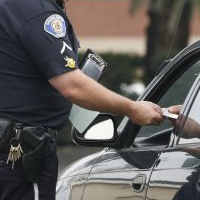Why a $100 California Traffic Fine Ends up Costing $549
 Police officer issues a citation in Santa Ana (photo: Joshua Sudock, Orange County Register)
Police officer issues a citation in Santa Ana (photo: Joshua Sudock, Orange County Register)
Traffic fines are far more than crime deterrents and punishment for violations in California; they are a major source of revenue that become more critical to local and state governments in tough economic times. In 2006, the California Research Bureau calculated that traffic violations generated $502.6 million in revenue, and that was before the Great Recession.
Although most everyone reading this has received a ticket and been through the exasperating process of shelling out hundreds of dollars for a violation, few people know what they are really paying for because California wraps a lot of fees and assessments into the bill that have nothing to do with the infraction.
Caroline Chen at the Center for Investigative Reporting (CIR) broke down a fine received by one Derick Neal, who was dinged for a rolling stop in San Leandra during a right turn at a traffic light, and counted 11 separate charges in addition to the base fine of $100. That brought the bottom line to $549.
Neal’s experience was typical. Drivers in the state were issued more than 6 million citations last year, often in the $400-$500 range. That pencils out to $2.4 billion at the low end.
The charges on Neal’s ticket, in addition to the base fine, included: a state penalty assessment ($100), a county penalty assessment ($70), traffic school ($59), DNA identification fund ($50), court construction ($50), court operations ($40), conviction assessment ($35), state surcharge ($20), emergency medical services ($20), emergency medical air transportation ($4) and night court ($1).
Base fines are set by the California Judicial Council and additional assessments are dictated by the Legislature.
While the charges may all be for worthy causes, some question whether sticking the bill on traffic tickets is a fair way of spreading the cost of government. Fees are inherently more regressive than taxes and harder on people with lower incomes, who end up spending a larger percentage of their income on them. But fees are much easier for lawmakers to assess than taxes, which still evoke a firestorm of protest 35 years after Prop. 13 fever swept the state.
Using traffic tickets as a vehicle for collecting infrastructure and service revenues is an incentive for law enforcement to be especially zealous in their collection activities, contributing to conflicts in the field and disrespect for the law in general. It encourages illegal quota systems, raises suspicions about police motives and shifts law enforcement away from more serious crime fighting and prevention.
It also creates a complicated system of justice not easily discerned by the electorate. In 2006, the Judicial Council counted 269 separate court fines, fees, forfeitures, surcharges and penalty assessments that appeared in statutes in 16 different government codes. County clerks are forced to keep multiple ledgers detailing the disbursement of funds far and wide.
Some of the ostensible costs, like court operations, are actually exacerbated by lumping them on a traffic ticket. CIR cited Judicial Council statistics that show the number of people contesting tickets has kept pace with the ever-escalating fines, rising from 4.5% in 2003 to 7.1% in 2011.
Cottage industries devoted to helping people game the system have thrived but none of that helped Neal. Although courts sometimes offer a discount on the fine in exchange for a guilty plea, Neal pleaded not guilty, lost and was forced to pay the full cost of his ticket.
–Ken Broder
To Learn More:
California Drives up Traffic Fines with Fees Earmarked for Projects (by Caroline Chen, Center for Investigative Reporting)
Cash-Strapped California Increasing Traffic Fines Again (by Nardine Saad, Los Angeles Times)
“California Stops” Are Getting Costly (by Sandy Mazza, Torrance Daily Breeze)
Who Pays for Penalty Assessment Programs in California? (by Marcus Nieto, California Research Bureau) (pdf)
- Top Stories
- Controversies
- Where is the Money Going?
- California and the Nation
- Appointments and Resignations
- Unusual News
- Latest News
- California Forbids U.S. Immigration Agents from Pretending to be Police
- California Lawmakers Urged to Strip “Self-Dealing” Tax Board of Its Duties
- Big Oil’s Grip on California
- Santa Cruz Police See Homeland Security Betrayal in Use of Gang Roundup as Cover for Immigration Raid
- Oil Companies Face Deadline to Stop Polluting California Groundwater





